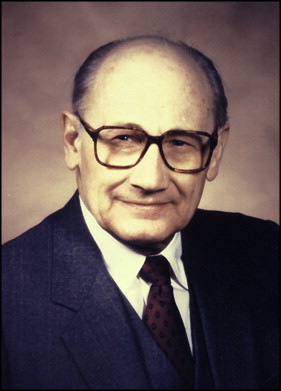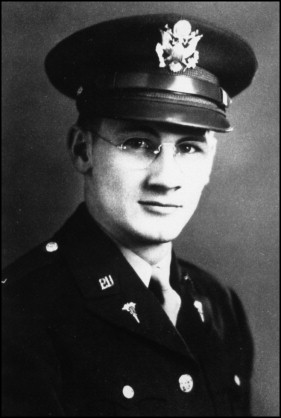Highlights
- •
This article describes the life and accomplishments of Dr Robert E Moyers (1919-1996).
- •
He was the most decorated dental officer to serve during World War II.
- •
He was chairman of the Departments of Orthodontics at the Universities of Toronto and Michigan.
- •
He was the founder of the Center for Human Growth and Development at the University of Michigan.

One of the more colorful persons in orthodontics and craniofacial biology of his generation was Robert E. Moyers ( Fig 1 ), the former chairman of the Department of Orthodontics at the University of Michigan and the founding director of the Center for Human Growth and Development, an interdisciplinary research unit on the Ann Arbor campus.

So who was Bob Moyers? Robert Edison Moyers was born on November 12, 1919, in Sidney, Iowa, where he spent his childhood and most of his adolescence. Shortly after graduating from high school in 1937, Bob went to Iowa City where he worked to earn enough money to begin his education at the University of Iowa that fall. At age 17, he entered the College of Liberal Arts, where he was enrolled in the honors English program. Bob also was a member of the University Players (he always had a flair for the theatrical).
During his undergraduate years, Bob served as student pastor at a small church near Iowa City, earning the nickname “Deacon.” Because of his success as a preacher, he continued to serve as pastor until he finished dental school at the University of Iowa, graduating in December 1942, at which time he began his military career.
Bob was assigned to the Office of Strategic Services, the wartime intelligence agency that was the predecessor of the Central Intelligence Agency. In preparation for his new duties, Dr Moyers underwent intensive training in physical conditioning, cryptography, parachuting, and survival techniques. As one of a group of 5 soldiers, Bob parachuted into Greece on the second anniversary of Pearl Harbor; they were the first Americans to do so. There, Major Moyers ( Fig 2 ) served as the senior allied medical liaison officer to the Greek resistance movement.

Major Moyers was discharged in early September 1945, leaving the Army with a Bronze Star, Legion of Merit, Purple Heart (he was wounded twice), Order of the British Empire, and Order of Phoenix (Greek). Bob was the most highly decorated dental officer to serve in World War II—a true war hero.
In late September 1945, Bob returned to Iowa City to begin his graduate work in orthodontics. He received his master’s degree in 1947 and a doctoral degree in neuromuscular physiology in 1949. At the University of Iowa, Bob was a pioneer in electromyography; he was one of the first persons to monitor the electrical activity in the masticatory and facial muscles. His doctoral thesis earned him what is now called the Milo Hellmann Research Award, the highest research award given by the American Association of Orthodontists.
After completing his doctoral research, Bob was appointed chair of the Department of Orthodontics at the University of Toronto in 1949. At Toronto, he established 2 research centers: the Burlington Orthodontic Research Centre and the Craniofacial Anomalies Clinic at the Hospital for Sick Children. Both of these research centers are still active today.
After the sudden death of Dr George Moore at the University of Michigan, Bob was asked to assume the chairmanship of its Department of Orthodontics, a position he accepted in 1952. Early in his career in Ann Arbor, Bob became involved with the University of Michigan Elementary and Secondary School Growth Study, adding cephalometric and hand-wrist film data to the information gathered annually from students enrolled in the university’s “laboratory school” in the School of Education. This extensive database has served as a research source for many scholars at the University of Michigan and for those who have come from around the world to study and conduct research there. Two atlases of normal craniofacial growth continue to be widely used resources.
In 1963, the University of Michigan began an initiative to establish an interdisciplinary research unit in human development on campus. Because Bob had taken much of his education at the Iowa Growth Center, the dean of the dental school asked him to represent the School of Dentistry on this committee. Bob ultimately became the founding director of the Center for Human Growth and Development (CHGD) that was established in 1964.
When I came to Ann Arbor in 1968 to start my doctoral work in anatomy, it was a time of intense intellectual excitement at the CHGD. Other faculty members connected with the CHGD included bone biologist Donald Enlow, embryologist Alphonse Burdi, anthropologist Stanley Garn, and morphometrician Fred Bookstein. During his tenure as director of the CHGD (1964-1980), Bob convinced many visiting scholars to take their sabbaticals at the University of Michigan, usually for a period of a year or more. Visiting scholars at the CHGD during the late 1960s and early 1970s included Leif Linge from Norway, Frans van der Linden and Herman Duterloo from The Netherlands, José Carlos Elgoyhen from Argentina, Kalevi Koski from Finland, and Takayuki Kuroda from Japan. Dental students (and future orthodontists) Mike Riolo, Bill Northway, and Lee Graber also were in the mix.
Three notable postdoctoral scholars were at the CHGD in the mid-1970s: Rolf Behrents, Lee Graber, and physical anthropologist David Carlson. Other international scholars who became part of CHGD in the mid-to-later part of the 1970s included Alexandre Petrovic from France, Jos Dibbets from The Netherlands, and Daryl Bowden from Australia. Each of them enhanced the intellectual atmosphere of the CHGD greatly, and many participated as speakers at subsequent Moyers Symposia.
Bob served as director of the CHGD until 1980 and continued to head its Craniofacial Biology Group for another decade. In 1990, he retired and became fellow emeritus of the CHGD and professor emeritus of dentistry. He also retired from his private orthodontic practice, but he continued to be a productive researcher until his unanticipated death in 1996 at age 76.
Bob Moyers was one of the most creative and innovative faculty members at the University of Michigan. His horizons were far broader than dentistry and orthodontics, as indicated by his vision that led to the founding of the CHGD, as well as by his leadership and coordination of the disparate research foci of the biologists and psychologists comprising the CHGD faculty. Through his pioneering efforts, the CHGD gained international prominence for its interdisciplinary research not only in craniofacial biology, but also in developmental psychology, developmental biology, nutrition and public health, morphometrics, anthropology, and pediatrics.
Bob’s first love, however, was orthodontics, and his contributions to the specialty were immense. His doctoral investigations and subsequent clinical research provided a better understanding of the role of the neuromusculature both in normal facial growth and during clinical treatment. His leadership of a project funded by the National Institutes of Health in craniofacial growth and development led to a broader understanding of the form-and-function relationship in the craniofacial region. Bob also wrote an orthodontic textbook that was used widely throughout the world for many decades.
The memories of Bob’s life and accomplishments are kept alive through the Moyers Symposium held in Ann Arbor each March. This event, now in its 43rd year, was started in 1974 through the gift of a grateful dental student, Dr Verne Primack. The Symposium has grown over the years to become the most well-respected and internationally known meeting of its kind. The Moyers Symposium is a living memorial to a most deserving visionary, leader, and motivator.
Stay updated, free dental videos. Join our Telegram channel

VIDEdental - Online dental courses


